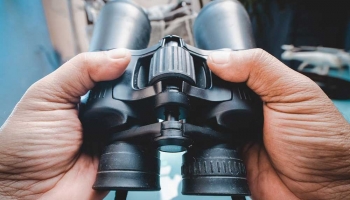How Far Can You See With 20×50 Binoculars?
Distance is an important factor when choosing the right product. When using 20x50mm binoculars, the first number means that images will appear 20 times closer. For example, a target 100 yards away looks as if it’s 5 yards away. The second number refers to the size of its objective lens, which is 50mm. With a pair of 20x50mm binoculars, far away objects will appear to be significantly closer, and you’ll be able to spot things that you otherwise wouldn’t be able to with the naked eye. However, the limit on how far you can see is still based on both terrain and the curvature of the Earth, so keep in mind there is a limit to your visibility.
These specifications make it more suitable for some applications rather than others. One of the drawbacks of the high magnification power is that they may not be effective when focusing on objects at close range. The optical instruments have a close-focusing distance of 45 feet. Therefore, objects closer than 45 feet will appear blurry. If you opt for high magnification, you won’t get a clear view if your hands are shaking or your device is moving. A tripod is recommended.
Best Uses for 20×50 Binoculars
If you’re a beginner looking to buy your first long-range binoculars, the 20×50 binoculars are perfect choices.
High-magnification binoculars are ideal for greater distances. They are a perfect choice for people looking for a quality pair of long-range devices for casual use. Nature viewing, birding, and hunting. These optics can offer better views of sporting events from the nosebleed seats.
Special Considerations When Buying 20×50 Binoculars
There are several factors that you should consider besides the magnification power and the size of the objective lenses. Here are some considerations:
The Coatings of your Binoculars
Binoculars have lens and prism coatings. Lens coatings are effective across a wide spectrum of wavelengths and guarantee excellent performance. The lens coatings have many benefits, such as reducing glare and reflections, improving light transmission, and to producing vivid colors.
Eliminating reflections means you’ll get brighter and sharper images. You may find cheap coatings in the market, but they may not offer the quality you need for images. If the optics are coated, it means that at least one of the lenses have coatings. If your device is multi-coated, it means several surfaces have coatings, or they have multiple layers of coatings.
On the other hand, prism coatings are used for complementing the lens coatings. They allow almost 100% of light through the prism, and this leads to brighter images. Some users cannot tell the difference between different types of prism coatings, but professionals may require them to ensure they get detailed images at a distance and in low light.
The Type of Prisms
Porro and roof prisms are the two types of prisms in the optical devices. The former was invented in the 1850s and revolutionized the world of binoculars. A few decades later, roof prisms were introduced.
Usually, devices with Porro prisms are cheaper than their counterparts, as their manufacturing process is cheaper. They are commonly used in large binoculars used by astronomers. Over time, roof prisms have become more popular. They allow manufacturers to make devices with a more streamlined appearance, and this makes them lighter.




